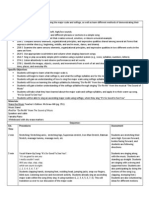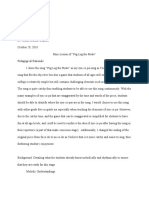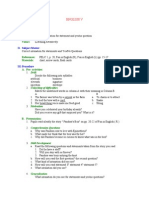Whenyoubelievelesson
Whenyoubelievelesson
Uploaded by
api-266873668Copyright:
Available Formats
Whenyoubelievelesson
Whenyoubelievelesson
Uploaded by
api-266873668Original Title
Copyright
Available Formats
Share this document
Did you find this document useful?
Is this content inappropriate?
Copyright:
Available Formats
Whenyoubelievelesson
Whenyoubelievelesson
Uploaded by
api-266873668Copyright:
Available Formats
ENSEMBLE REHEARSAL PLAN
Conductors Name: Alexa Kleiman Zimmerman Ensemble Name: 6th Grade Chorus
Title of Piece: When You Believe (Hal Leonard Corporation)
Composer/Arranger: Stephen Schwartz, Choral Arr. Audrey Snyder, Instrumental Arr. John Moss
Grade of Piece: Middle School/6th grade
Learning Goals (Objectives):
What singers will:
Be able to do (behavioral): The singers of the 6th grade chorus will be able to
accurately perform an arrangement of When You Believe by composer Stephen Schwartz
Understand (cognitive): The singers will have perspective on the musical techniques
needed in order to make a piece performance ready and interpret the lyrics with how it
correlated to the time period.
Encounter (experiential): The members of the sixth grade chorus will experience a
performance ready example of When You Believe by Stephen Schwartz through a YouTube
video and work together to analyze techniques used to enhance their own performance.
Construct meaning (constructivist): Members of the sixth grade chorus at Carusi
Middle School and Beck Middle School will realize the relationship between music, text, and
historical time period as it relates to meaning, expression, and interpretation.
Aligns with the New Jersey Core Arts Standards: MU:Pr4.2.E.5a, MU:Re8.1.E.5a,
MU:Re9.1.E.IIa, MU:Cn10.0.H.5a
Technical Skills (Intonation, Breath, Posture, Phonation, Balance, Bowing, Sticking for
Percussion, Diction for Singers)
Clear diction with specic attention to the Hebrew text in the middle of the piece.
Intonation of a minor key, with attention to two key changes. Strong breath support for
connected phrasing.
Musical Concepts (Melody, Rhythm, Harmony, Form, Timbre, Texture)
Proper distinction of staccato during the Hebrew section, following the descending
harmony line against the melody during sections of the chorus, simple rhythmic patterns,
challenging range for soprano line, simple compositional form with a bridge.
Empowering Musicianship (Historical Perspective, Stylistic Integrity, Musical Artistry)
After learning about the history of this piece, the members of the sixth grade chorus will
apply their new knowledge to enhance the overall feel for an artistic performance.
Process
Warm Up (Introduction to choral selection, historical information to help guide the overall feel of
the piece, vocal warm ups)
Focus exercise:
-
What is brain noise? (extra thought outside of the current activity.) Things like, what
am I having for dinner?, What do I have to do for the next class?
-
Thoughts like this are not needed for what we are currently doing. We are going to do
this exercise to eliminate brain noise.
-
Count out loud with me, 1, 2, 3, 4, 5, 6, 7, 8, repeat.
-
Have students continuously speak out the numbers on the downbeat of a 4/4 pattern
-
When my hands are facing up, you speak the numbers out loud, when my hands are
facing down, you count the number in your head. Dont lose track of where we are.
-
If students have a hard time understanding, model an example for them.
-
patterns: up-up-up-down-up-up-up-up; up-down-up-up-down-up-up-up; up-down-
down-up-up-down-down-up; up-down-up-down-down-down-down-up.
At the start of rehearsal, begin with stretches:
-
Stretch arms straight up and reach the sky, try to reach the ceiling.
-
Slowly bring the arms down but keep your rib cage up (try again)
-
Roll shoulders: forward, backwards, one forward and one backwards
-
Lightly pat your arms and wake them up
-
Massage your neck up to your jaw
-
Feet shoulder width apart
-
Breathe in for 3 counts, and hiss out on 4. Hold as long as you can and sit down when
youve run out of air.
-
Imagine a string attached to the top of your head and while keeping your feet at on
the oor, someone or something is slightly pulling the string upwards. The string isnt
pulled so much so that it strains anything, but just enough to elongate your posture.
-
We do this so all of our body is open enough for our breath to be easily supported for
great sounding music
Vocal Warm ups:
-
I love to sing (1, 8, 5, 3, 1/do, do, so, mi, do)
-
Pretend like you are holding a nail and your other hand acts like the hammer. Pretend
like you are hammering the nail into a wall when you sing this: Ming, ming, ming,
ming, ming (5, 4, 3, 2,1/fa, so, me, re, do)
-
Pretend like you are pulling a rope. Once from the right, and once from the left. Me-
eh-me-eh-me-eh-me-eh-me (5, 3, 4, 2, 3, 1, 2, 7, 1/so, mi, fa, re, mi, do, re, ti, do)
Few very nasal then transition to a few open tone with spacial vowels.
-
Simple vowel major third ascending and descending, then minor thirds to introduce
the feel of the song
-
**When rehearsal the Hebrew section: Nai Up a forth and back
Teach song by rote:
Sing through rst verse and chorus for students.
Teach line by line of verse, sing the whole verse
Teach line by line of chorus, sing the chorus
Put both sections together.
Teach line by line of verse two, sing the whole verse
Teach the second chorus and how it adds the echoes, sing the chorus
Put both sections together
Sing verse 1, chorus, verse 2, chorus 2
Hebrew section:
-
Repeat after me: Ashira (Ashira), lAdonai (lAdonai) ki ga-oh ga-ah (ki ga-oh ga-
ah)
-
Ashira lAdonai ki ga-oh ga-ah (Ashira lAdonai ki ga-oh ga-ah) Repeat if needed
-
Micha mocha (Micha mocha), ba-e-lim (ba-e-lim), adonai (adonai)
-
Micha mocha ba-e-lim adonai
-
ne-dar (ne-dar), ba-ko-desh (ba-ko-desh)
-
ne-dar-ba-ko-desh (ne-dar-ba-ko-desh)
-
na-chi-tah (na-chi-tah)
-
vchas-dcha (vchas-dcha)
-
am zu ga-al-ta (am zu ga-al-ta)
Show visuals of Hebrew by line, speak in rhythm rst, then vocally.
1. Ashira lAdonai ki ga-oh ga-ah
2. Ashira lAdonai ki ga-oh ga-ah
3. Micha mocha ba-e-lim adonai
4. Micha mocha ne-dar-ba-ko-desh
5. Na-chi-tah vchas dcha am zu ga-al-ta
6. Na-chi-tah vchas dcha am zu ga-al-ta
7. Ashira ashira ashira
Present: (Ensemble members in specic voice part collaborate together predictions on how to
enhance the performance by watching a video of a chorus performing this piece. Locate the
challenges and brainstorm the solutions together by responding). This can be done during the
sectional rehearsals.
Singers in the sixth grade chorus will watch a choral performance of _____ singing
When You Believe by Stephen Schwartz. After the video is completed, students will break off
in groups within their section to discuss what they liked about the video, and what they need to
do in order for them to sound the same. The students will also discuss what they think are the
challenging sections of the piece and what they think they could do to help x the issues. The
groups will write their ideas on a piece of paper. After a couple minutes go by, we will go around
to each group to discuss what they have come up with.
Have singers return to their seats (if at Carusi) and sing the entire song with the
discussed ideas intact. The group will also pay attention to articulation, phrasing, breath marks,
and the dotted 8th notes to the sixteenth pairings.
The conductor along with the singers of the 6th grade chorus will work together to make
this piece performance ready. Everyone will pay attention to the expression of the piece, and
make sure the meaning of the lyrics are coming through.
Perform: (Demonstrate teaching music when singers perform)
The sixth grade chorus at Carusi Middle School combined with Beck Middle School will
perform the piece, When You Believe by Stephen Schwartz at a combined music winter
concert.
Assessment:
Formative: Student engagements will strengthen with the ability to work in groups within
their voice sections. The students will participate in a dialogue about musical techniques and
how it can impact the performance of the piece.
Summative: The students will show their mastery of musical concepts as it relates to
expression by performing the choral piece, When You Believe in the winter concert.
Integrative: Teacher reects on the following questions:
1. Did students understand the connection between the history of the piece and the connection
of the lyrics?
2. In what ways, did the students perceptions change when working on this piece?
3. Having worked on this piece, what have I noticed that could help improve my future teaching
as a conductor?
4. In what ways did the singers nd value in working together to improve the overall
performance of the piece?
You might also like
- Never Enough - Citizen QueenDocument30 pagesNever Enough - Citizen QueenPetrick Luandy Salhuteru50% (6)
- The Wedding SATBDocument5 pagesThe Wedding SATBKevin John MorcosoNo ratings yet
- Bring Me Little Water Sylvie Master PlanDocument3 pagesBring Me Little Water Sylvie Master Planapi-242480548No ratings yet
- Al Slosham D Varim - Lesson PlanDocument4 pagesAl Slosham D Varim - Lesson Planapi-251763107No ratings yet
- John Kanaka Lesson PlanDocument2 pagesJohn Kanaka Lesson Planapi-314978735No ratings yet
- A Child Is Born in BethlehemDocument3 pagesA Child Is Born in BethlehemUNAMBA VICTORNo ratings yet
- You Are The LightDocument3 pagesYou Are The Lightchoir master of many100% (1)
- Blue Skies Lesson PlanDocument4 pagesBlue Skies Lesson Planapi-266873668No ratings yet
- One Star Lesson PlanDocument4 pagesOne Star Lesson Planapi-266873668No ratings yet
- Can You Hear Lesson Plan MC ZGDocument3 pagesCan You Hear Lesson Plan MC ZGapi-266111651No ratings yet
- Elementaryteachingunit 1Document52 pagesElementaryteachingunit 1api-357472068No ratings yet
- Still I Rise Lesson Plan BV ZGDocument3 pagesStill I Rise Lesson Plan BV ZGapi-266111651No ratings yet
- College of St. John-Roxas Learning Plan: Supervisory Form 3Document3 pagesCollege of St. John-Roxas Learning Plan: Supervisory Form 3Katherine BrinosaNo ratings yet
- College of St. John-Roxas Learning Plan: Supervisory Form 3Document3 pagesCollege of St. John-Roxas Learning Plan: Supervisory Form 3Katherine BrinosaNo ratings yet
- Second Grade Steady Beat Lesson PlanDocument3 pagesSecond Grade Steady Beat Lesson Planapi-4583811010% (1)
- Elementary UnitDocument39 pagesElementary Unitapi-526541358No ratings yet
- Gates-Lake Isle Ubd FromatDocument6 pagesGates-Lake Isle Ubd Fromatapi-266111651No ratings yet
- Assessment Project MUED 400: Ensemble For Project: Grade 7 General MusicDocument12 pagesAssessment Project MUED 400: Ensemble For Project: Grade 7 General Musicapi-317436240No ratings yet
- Drum ImprovDocument3 pagesDrum Improvdl1485No ratings yet
- 2010 08 Elementary Teaching UnitDocument63 pages2010 08 Elementary Teaching Unitapi-534143050No ratings yet
- Stravinskys Ave Maria Rehearsal PlanDocument4 pagesStravinskys Ave Maria Rehearsal Planapi-279999720No ratings yet
- Edtpa Lesson Plans 1-4Document10 pagesEdtpa Lesson Plans 1-4api-254150563No ratings yet
- Lake Isle of Innisfree Lesson Plan BV ZGDocument4 pagesLake Isle of Innisfree Lesson Plan BV ZGapi-266111651100% (1)
- Hava Nagila Lesson 3Document4 pagesHava Nagila Lesson 3api-316334860No ratings yet
- Lesson Plan 1 PDFDocument3 pagesLesson Plan 1 PDFAndre Lorenz FeriaNo ratings yet
- SecondaryunitfinalDocument11 pagesSecondaryunitfinalapi-439220457No ratings yet
- Music 670 Elementary Teaching Unit Concept: Syncopation 4 Grade Jessica BrummelDocument51 pagesMusic 670 Elementary Teaching Unit Concept: Syncopation 4 Grade Jessica BrummelJessica BrummelNo ratings yet
- Eurhythmics BUTKE PDFDocument5 pagesEurhythmics BUTKE PDFSharon Kim100% (1)
- Fielding-Mus149-Assignment 4Document4 pagesFielding-Mus149-Assignment 4api-510874732No ratings yet
- Hava Nagila Lesson 5Document4 pagesHava Nagila Lesson 5api-316334860No ratings yet
- Individual Lesson AnalysisDocument3 pagesIndividual Lesson Analysisapi-709255819No ratings yet
- Elementary Music Example Lesson PlanDocument4 pagesElementary Music Example Lesson Planapi-643288266No ratings yet
- Elementary UnitDocument46 pagesElementary Unitapi-649553832No ratings yet
- Lesson Plan For Observation 2020-2021Document4 pagesLesson Plan For Observation 2020-2021Joseph GiammonaNo ratings yet
- Music Key Stage 1 & 2 - Schemes of Work - Unit 4Document15 pagesMusic Key Stage 1 & 2 - Schemes of Work - Unit 4Ju-Rey Delos Reyes ForondaNo ratings yet
- Intro Musical Theatre Lesson FinalDocument11 pagesIntro Musical Theatre Lesson Finalapi-283596499No ratings yet
- 10 Play It Again - Exploring Rhythmic PatternsDocument3 pages10 Play It Again - Exploring Rhythmic PatternsAndyBrooke100% (1)
- Conversational Solfege HighlightsDocument12 pagesConversational Solfege Highlightsanthonyhealy25No ratings yet
- Elementary Teaching UnitDocument5 pagesElementary Teaching Unitapi-715505673No ratings yet
- 33654331Document10 pages33654331Albert CarbonellNo ratings yet
- Mccarley-Mus149-Assignment 4Document4 pagesMccarley-Mus149-Assignment 4api-534929153No ratings yet
- Gates Canyouhear UbdDocument6 pagesGates Canyouhear Ubdapi-266111651100% (1)
- TEAM Lesson Plan Template: UT MartinDocument5 pagesTEAM Lesson Plan Template: UT Martinapi-253217748No ratings yet
- Henry 6th Grade 4-25 LessonDocument1 pageHenry 6th Grade 4-25 Lessonapi-247856113No ratings yet
- 22what Makes You Beautiful 22 Lesson PlanDocument4 pages22what Makes You Beautiful 22 Lesson Planapi-302905223No ratings yet
- Unit 15 Ongoing Skills: Extension and Future LearningDocument4 pagesUnit 15 Ongoing Skills: Extension and Future LearningAndyBrookeNo ratings yet
- Revised Mini Lesson of Peg Leg The PirateDocument5 pagesRevised Mini Lesson of Peg Leg The Pirateapi-371835039No ratings yet
- Conduct The OrchestraDocument4 pagesConduct The Orchestraapi-263448107No ratings yet
- The Song of ShapesDocument1 pageThe Song of Shapesapi-310989398No ratings yet
- The Song of Shapes 1Document1 pageThe Song of Shapes 1api-314100783No ratings yet
- The 20song 20of 20shapes-2Document1 pageThe 20song 20of 20shapes-2api-310433410No ratings yet
- Lessons For ProjectDocument9 pagesLessons For Projectapi-272768148No ratings yet
- Fetterman-Mus149-Assignment 4Document6 pagesFetterman-Mus149-Assignment 4api-534076919No ratings yet
- Elementary Unit Full DocumentDocument32 pagesElementary Unit Full Documentapi-491299906No ratings yet
- STP Lesson PlansDocument4 pagesSTP Lesson Plansapi-709255819No ratings yet
- Fetterman-Mus149-Assignment 4Document6 pagesFetterman-Mus149-Assignment 4api-534617293No ratings yet
- Vocal Choral Techniques Fairfield UDocument14 pagesVocal Choral Techniques Fairfield UJason Tiongco100% (1)
- Vocal and Choral TechniquesDocument14 pagesVocal and Choral TechniquesNa'im Suhaimi100% (2)
- Lesson Plan: Strophic Form: Context/Prior Knowledge Essential Question MaterialsDocument5 pagesLesson Plan: Strophic Form: Context/Prior Knowledge Essential Question Materialsapi-551389172No ratings yet
- Hallelujah LessonDocument2 pagesHallelujah Lessonapi-215775183No ratings yet
- Adaptive Dance and Rhythms: For All Ages with Basic Lesson Plan, 2nd EditionFrom EverandAdaptive Dance and Rhythms: For All Ages with Basic Lesson Plan, 2nd EditionNo ratings yet
- Chrisa Kitsiou, Music Theory - Solfège, Developing Aural Skills - Book 1From EverandChrisa Kitsiou, Music Theory - Solfège, Developing Aural Skills - Book 1No ratings yet
- The Structures and Movement of Breathing: A Primer for Choirs and ChorusesFrom EverandThe Structures and Movement of Breathing: A Primer for Choirs and ChorusesNo ratings yet
- Voice TrainingDocument2 pagesVoice Trainingwcw3306100% (4)
- What Is A Speech ChoirDocument33 pagesWhat Is A Speech ChoirJennifer JuatcoNo ratings yet
- Panginoon Maawa KaDocument1 pagePanginoon Maawa KaHenson CastilloNo ratings yet
- F D C B F F C D: Tenor/BassDocument2 pagesF D C B F F C D: Tenor/BassBookfood InternationalNo ratings yet
- Ellen White's Instruction On MusicDocument6 pagesEllen White's Instruction On MusicPrince StudioNo ratings yet
- Original Production of Virgil Thomson and Gertrude Stein's: Four Saints in Three ActsDocument16 pagesOriginal Production of Virgil Thomson and Gertrude Stein's: Four Saints in Three ActsJared RedmondNo ratings yet
- Muhammad Yogi Rizaldy X Ips 3Document7 pagesMuhammad Yogi Rizaldy X Ips 3BilalNo ratings yet
- Ama Namin SATB A CappellaDocument3 pagesAma Namin SATB A CappellaAbner Ryan S. TauroNo ratings yet
- Breathing Made Simple E-BookDocument17 pagesBreathing Made Simple E-BookErin100% (1)
- Frozen Audition FormDocument2 pagesFrozen Audition Formapi-455634799No ratings yet
- Taylor Swift: The Whole Story - Excerpt: The Wit and Wisdom of Taylor SwiftDocument64 pagesTaylor Swift: The Whole Story - Excerpt: The Wit and Wisdom of Taylor SwiftAnonymous ikUR753am100% (2)
- ENGLISH V 1st RatingDocument78 pagesENGLISH V 1st RatingMichael Joseph Santos100% (1)
- Song FileDocument8 pagesSong FileJeremy MorrisonNo ratings yet
- Analysis Paper 2Document4 pagesAnalysis Paper 2api-303657568No ratings yet
- The 5 Countertenors: Yuriy Mynenko Xavier Sabata Max Emanuel Cencic Valer Sabadus Vince YiDocument17 pagesThe 5 Countertenors: Yuriy Mynenko Xavier Sabata Max Emanuel Cencic Valer Sabadus Vince YiJean-Emmanuel AssemNo ratings yet
- David HykesDocument12 pagesDavid HykesMikeSufi100% (2)
- 02 Application GuideDocument5 pages02 Application Guidemarkarquelacanaria2022No ratings yet
- Program Handbook 2014-2015Document61 pagesProgram Handbook 2014-2015Paul CorreaNo ratings yet
- Charpentier Te Deum Choir PDFDocument8 pagesCharpentier Te Deum Choir PDFMicaelaNo ratings yet
- Vocal Technique Training For Choir MembersDocument44 pagesVocal Technique Training For Choir MembersJay WijayantoNo ratings yet
- Cristo, Meu MestreDocument1 pageCristo, Meu Mestretizo marcondesNo ratings yet
- Garganta - Las Music 9 Q4 W5-6Document4 pagesGarganta - Las Music 9 Q4 W5-6Aiah CorderoNo ratings yet
- Grade Iii Performance Standards Most Essential Learning Competencies ActivitiesDocument3 pagesGrade Iii Performance Standards Most Essential Learning Competencies ActivitiesMaurice OlivaresNo ratings yet
- I Wanna Dance With Somebody Voc ArrDocument10 pagesI Wanna Dance With Somebody Voc ArrLars Mathijssen100% (1)
























































































